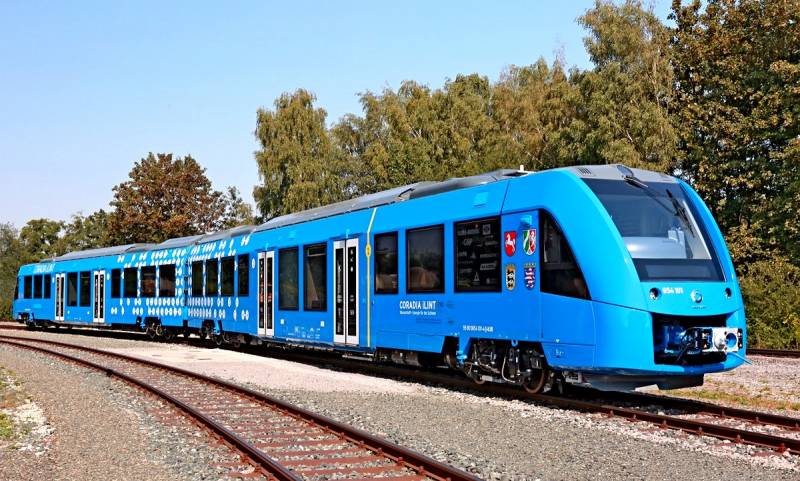Hydrogen train: a revolution in energy?
The first hydrogen train in the world began operating in Germany this week. With a zero level of harmful emissions, it can carry up to three hundred passengers at a speed of 140 kilometers per hour. A unique train operating on "water and oxygen" was called Coradia iLint. Such a composition itself still surpasses the price of a regular diesel one, but its operation will cost less and it is as environmentally friendly as possible, which is important for consumers of developed countries.
Does the appearance of a hydrogen train mean a real revolution in world energy? Let's try to figure it out.
The main fuel for millions of transport units is petroleum products. Burning "black gold" in internal combustion engines is beneficial to small owners of oil wells, but it is very irrational. It is believed that the famous Russian scientist Dmitry Mendeleev compared this use of oil with the furnace furnace with bank notes. It is much more reasonable to get all kinds of plastics and synthetic fabrics from it. In addition, do not forget that oil is an exhaustible natural resource.
The search for alternative energy sources has been going on for a long time. These are cheap but dangerous nuclear energy, wind and tidal power plants, solar energy storage devices, etc. All this is very interesting, but not quite suitable for millions of cars, since millions of powerful batteries, which are also produced using rare earth elements, will be needed to charge them. Fashionable today, “Tesla” cannot become a mass mode of transport in the foreseeable future for a number of reasons.
The use of biofuels is being considered. But it also has drawbacks with obvious advantages, these are: the use of plants suitable for nutrition for its production, which poses a certain ethical problem in the presence of starving countries; during its production, energy is also consumed and carbon dioxide is released into the atmosphere. But in a number of countries, for example, Brazil, bioethanol produced from sugarcane is able to occupy its market niche.
Scientists have proposed using energy contained in hydrogen. Thanks to the electrolysis reaction, it can be extracted from water. This requires powerful energy sources like a nuclear power plant. But what if we started the process of generating electricity directly in the engine, the developers thought? An explosive gas was converted into a stable compound called sodium borohydride. The fuel tank was placed on the roof of the German train. Energy for the engine is generated safely using hydrogen cells through an electrochemical reaction. To optimize electricity consumption, batteries are provided that accumulate and issue it at the right time.
Experts do not yet consider hydrogen engines as a panacea for all problems, but great potential lies in this direction. To disclose it requires huge investments in infrastructure and time. But after all, ICE cars could become mass only when roads were built under them with a network of fuel stations.
Does the appearance of a hydrogen train mean a real revolution in world energy? Let's try to figure it out.
The main fuel for millions of transport units is petroleum products. Burning "black gold" in internal combustion engines is beneficial to small owners of oil wells, but it is very irrational. It is believed that the famous Russian scientist Dmitry Mendeleev compared this use of oil with the furnace furnace with bank notes. It is much more reasonable to get all kinds of plastics and synthetic fabrics from it. In addition, do not forget that oil is an exhaustible natural resource.
The search for alternative energy sources has been going on for a long time. These are cheap but dangerous nuclear energy, wind and tidal power plants, solar energy storage devices, etc. All this is very interesting, but not quite suitable for millions of cars, since millions of powerful batteries, which are also produced using rare earth elements, will be needed to charge them. Fashionable today, “Tesla” cannot become a mass mode of transport in the foreseeable future for a number of reasons.
The use of biofuels is being considered. But it also has drawbacks with obvious advantages, these are: the use of plants suitable for nutrition for its production, which poses a certain ethical problem in the presence of starving countries; during its production, energy is also consumed and carbon dioxide is released into the atmosphere. But in a number of countries, for example, Brazil, bioethanol produced from sugarcane is able to occupy its market niche.
Scientists have proposed using energy contained in hydrogen. Thanks to the electrolysis reaction, it can be extracted from water. This requires powerful energy sources like a nuclear power plant. But what if we started the process of generating electricity directly in the engine, the developers thought? An explosive gas was converted into a stable compound called sodium borohydride. The fuel tank was placed on the roof of the German train. Energy for the engine is generated safely using hydrogen cells through an electrochemical reaction. To optimize electricity consumption, batteries are provided that accumulate and issue it at the right time.
Experts do not yet consider hydrogen engines as a panacea for all problems, but great potential lies in this direction. To disclose it requires huge investments in infrastructure and time. But after all, ICE cars could become mass only when roads were built under them with a network of fuel stations.

Information